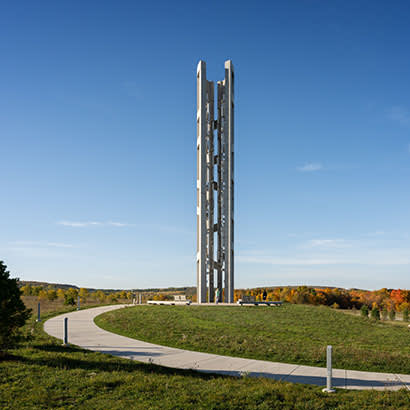
For an enhanced digital experience, read this story in the ezine.
What was once an abandoned coal mine is now forever transformed into a land of commemoration, heroism and healing. This is the legacy of the Flight 93 National Memorial.
Twenty years ago, on September 11, 2001, the United States came under attack when four commercial airliners departing from airports on the East Coast were hijacked and used to strike targets on the ground. After a delayed departure, United Airlines Flight 93 carrying 33 passengers, seven crew members and four hijackers departed Newark International Airport in New Jersey en route to San Francisco. Approximately 45 minutes into the flight, the plane changed course near Cleveland, Ohio, and was redirected southeast toward Washington, D.C. After action was taken by the passengers and crew members to overtake the hijackers, Flight 93 crashed a few minutes after 10 a.m. into a reclaimed coal strip mine near the town of Shanksville in Somerset County, Pennsylvania. Everyone on board was killed. An attack on the nation’s capital was prevented.
On September 24, 2002, Congress passed the Flight 93 National Memorial Act to commemorate the passengers and crew on board the flight. The memorial design was developed through a public competition that garnered more than 1,100 entries. Following a two-stage competition process, the selected design was announced on September 7, 2005. The project was then contracted through the National Park Service to develop the memorial design and integrate it with the requirements of a national park through a phased master plan.
“The traumas that happened on this land cannot and should not be forgotten,” states Paul Murdoch, architect of the Flight 93 memorial. “It has been an incredible honor to design a space that helps us to remember and to heal. It is my hope that the Flight 93 National Memorial will always memorialize the heroic legacies of the passengers and crew members and be a teaching tool to future generations asking,‘What can you do to strengthen democracy?’”
The Flight 93 National Memorial is now a 2,200-acre national park site. The design transforms the site, a former coal mine, into a landscape of environmental and symbolic healing.
Upon entering the park, visitors first see the 93-foot-tall Tower of Voices that introduces the memorial theme. The Tower of Voices features 40 tuned, wind-activated chimes that serve as a long-lasting remembrance of the brave voices of the 40 passengers and crew members.
The memorial landscape moves visitors through a composition of open spaces defined by site walls, plantings, walkways and courts, gateways, and building elements. The Field of Honor sits at the heart of the memorial landscape. Along the perimeter, memorial features include the Visitor Center, 40 Memorial Groves with a Red Maple Allée, the Wall of Names and Memorial Plaza, the Arrival Court and Gateway, the Sacred Ground, the Western Overlook and the restored wetlands.
The plane crashed at the edge of this open field, burning many of the surrounding hemlock trees. The distinct structure of the trees inspired the design motif expressed in materials throughout the memorial.
Every aspect of the memorial landscape repairs damaged land and water, from the restoration of meadows and wetlands to the remediation of soil and the planting of diverse native tree species.
Nearly two decades in the making, the Flight 93 National Memorial transforms this land of trauma into one of emotional healing, while signifying the strengths and sacrifices made by the heroes on Flight 93. The design and structure of the memorial expresses the spirit of the memorial’s mission statement preamble: “A common field one day. A field of honor forever.”
Thank you to Paul Murdoch Architects for contributing to this article.
Julie Du Brow is Principal of dubroWorks.


